Demand for Starlink’s low-Earth-orbit satellite internet service has surged beyond its core use case targeting rural and outlying areas, with many customers in cities around the world choosing it over terrestrial alternatives such as mobile and fibre.
But this has created a big headache for the Elon Musk-controlled SpaceX subsidiary, which has resorted to imposing high “demand surcharge” fees to customers wanting to sign up in areas where its network is congested.
Users in various parts of the US have reported additional fees ranging from US$100 (R1 780) to as much as $750 (R13 300) upon sign-up, with others in regions including parts of the UK and Australia also being charged in areas where there is insufficient capacity available.
“In areas with high demand, there is an additional one-time charge to purchase Starlink services,” the company explained on its website.
“The additional charge depends on the location of your service address, the service plan you choose and/or the Starlink kit you select. This charge will only apply if you are purchasing or activating a new service plan. If you change your service address or service plan at a later date, you may be charged the demand surcharge.”
Starlink said customers who are unhappy with its service and return its products for a refund within 30 days will also get the congestion surcharge fee back.
The surcharge will be used to develop additional capacity in areas where this is an issue. It raises concerns for Africa, where the lack of terrestrial internet infrastructure such as fibre and mobile broadband has led to Starlink being oversubscribed in many African cities.
Congestion surcharge
TechCentral reported in November 2024 that demand for Starlink services across Africa was so high that Starlink had to suspend new sign-ups.
SpaceX has taken a different approach in dealing with congestion in Africa. It may have halted new sign-ups in Africa due to the sheer volume of demand being higher than elsewhere in the world, where users have broad access to other connectivity options.
Read: Don’t expect Starlink in South Africa anytime soon
In Australia, for example, where a congestion surcharge of AU$140 (R1 620) is imposed, demand is driven by low fibre penetration. Despite being a developed country, only 29% of Australian homes have access to fibre, according to OECD data from February.
The challenge Australia has is that it is a large country with a population that is scattered over vast distances along its coastline. This makes rolling out fibre expensive.
 In Africa, fibre penetration is even lower – and is almost nonexistent in some cities. Australia’s buffer is that mobile broadband penetration rates are high, with over 95% of the population covered. The same cannot be said of major cities in Africa, including Nairobi, Lusaka or Lagos.
In Africa, fibre penetration is even lower – and is almost nonexistent in some cities. Australia’s buffer is that mobile broadband penetration rates are high, with over 95% of the population covered. The same cannot be said of major cities in Africa, including Nairobi, Lusaka or Lagos.
Speaking on a panel about the state of satellite connectivity at a Wireless Access Providers’ Association conference on Tuesday, Jens Langenhorst, founder of Specialised RF, believes Starlink use in South Africa, once the company is eventually licensed, will be higher on farms and smallholdings and lower in cities, especially where fibre is available. – © 2025 NewsCentral Media
Get breaking news from TechCentral on WhatsApp. Sign up here.

